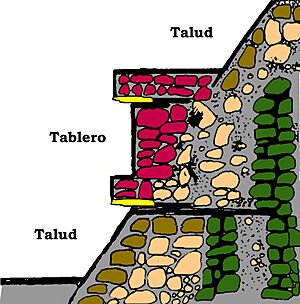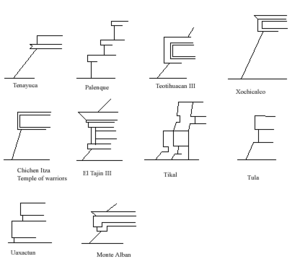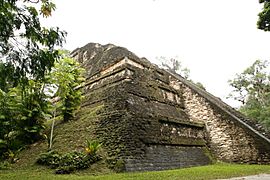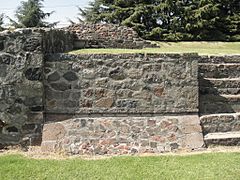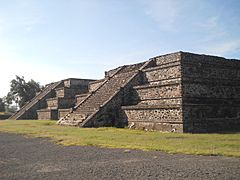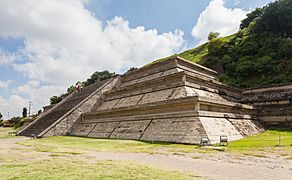Talud-tablero facts for kids
Talud-tablero is a special way of building that was very popular in ancient Mesoamerica. It was often used for platforms, temples, and large pyramids. This building style became well-known during the Early Classic Period in the city of Teotihuacan.
The word talud-tablero describes two main parts. The talud is a sloping wall or surface, like a ramp. The tablero is a flat, upright panel that sits on top of the sloping talud. You can also think of it as the slope-and-panel style.
Why Was Talud-Tablero Important?
This building style was often used when constructing pyramids in ancient Mesoamerica. You can find it in many cities and cultures. However, it is most strongly connected to the Teotihuacan culture in central Mexico. There, it was the main way buildings were designed.
When talud-tablero appeared in many cities, it showed how powerful Teotihuacan was. Teotihuacan was a major center for trade, art, and culture. Other cities might have used this style to copy Teotihuacan or to show they were connected to it.
Teotihuacan's influence was especially clear in new towns that grew during the Early Classic Period. These towns adopted the talud-tablero style. They might have even gotten help from Teotihuacan to become trading centers themselves. After Teotihuacan fell, other cities still used this style. They did this not just because of Teotihuacan, but because it had become a symbol of power. Many successful cultures had used it.
Many different versions of the talud-tablero style appeared across Mesoamerica. Each culture developed its own unique way of using it. For example, in the Maya city of Tikal, talud-tablero buildings appeared during the Early Classic Period. This suggests that Tikal had direct contact with Teotihuacan. Some think Teotihuacan might have even taken control of Tikal.
However, how other cities came into contact with Teotihuacan is not always clear. It likely involved trade and cultural exchanges. One idea from Juan Pedro Laporte suggests that Tikal might have developed talud-tablero on its own. This is because Tikal often used a type of molding that could have led to the slope-and-panel design.
Where Can You See Talud-Tablero?
The very first examples of talud-tablero buildings are not from Teotihuacan. They are found in older Pre-Classic buildings in the Tlaxcala-Puebla region. The oldest known example dates back to about 200 BC in Tlalancaleca, Mexico. We don't know if Teotihuacan learned the style from Tlalancaleca or if they created it independently.
Teotihuacan greatly influenced many other cities. This helped the talud-tablero building style spread across Mesoamerica. Here are some cities and structures that used talud-tablero:
- Cholula (Epiclassic Period): Builders found talud-tablero beneath the final layer of the Great Pyramid. The terraces at Cholula also copied this style.
- Kaminaljuyu (Guatemala, Classic Period): Talud-tablero style tombs were built for the city's important leaders.
- Matacapan (Classic Period): The main pyramid in this city used the talud-tablero style. This happened after Teotihuacan directly influenced Matacapan.
- Monte Albán (Classic Period): Many buildings in Monte Alban look similar to Teotihuacan's talud-tablero. However, they used a slightly different panel design.
- Nakum: This city used the talud-tablero style on the inside walls of four pyramids. These pyramids surrounded Patio 1 in the city.
- Teotihuacan: Most buildings in Teotihuacan used the talud-tablero style. The most famous examples are the Temple of the Sun, Temple of the Moon, and Temple of Quetzalcoatl.
- Tikal (Classic Period): Tikal has a talud-tablero building from around A.D. 200. Another large structure there seems directly influenced by Teotihuacan, with talud-tablero on two sides of a pyramid.
- Xochicalco: The most impressive building in Xochicalco is the Temple of the Feathered Serpent. It was built using the talud-tablero style.
Many other sites also feature talud-tablero architecture. Here is a table showing some of them, organized by when they were built:
| Early Classic | Middle Classic | Late Classic | Post Classic |
|---|---|---|---|
| Cholula | Tonina | Mitla | Tulum |
| Becan | Dzibilchaltun | Mexiquito | Tancah |
| Teotihuacan | Chinkultic | Teotenango | Tlatelolco |
| Edzna | Cacaxtla | Tula | Tenochititlan |
| Tepeapulco | Xochicalco | Chichen Itza | |
| Solano | El Ixtepete | ||
| Tikal | Copán | ||
| Monte Albán | |||
| Calixtlahuaca | |||
| Yohulichan | |||
| Ake | |||
| Kaminaljuyu | |||
| Oxkintok | |||
| Matacapan | |||
| Tazumal | |||
| Tingambato | |||
| El Tajín | |||
| Palenque |
See also
 In Spanish: Talud-tablero para niños
In Spanish: Talud-tablero para niños


